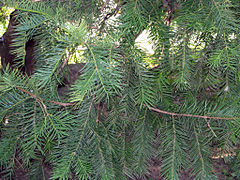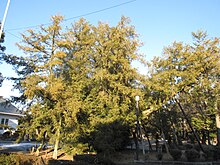Torreya nucifera
| Torreya nucifera | |
|---|---|

| |
| Torreya nucifera foliage | |
| Scientific classification | |
| Kingdom: | |
| Division: | |
| Class: | |
| Order: | |
| Family: | |
| Genus: | |
| Species: | T. nucifera
|
| Binomial name | |
| Torreya nucifera | |
Torreya nucifera is a slow-growing, coniferous tree native to southern Japan and to South Korea's Jeju Island. It is also called kaya (榧) or Japanese nutmeg-yew.
Description

It grows to 15-25 m tall with a trunk up to 1.5 m diameter. The leaves are evergreen, needle-like, 2-3 cm long and 3 mm broad, with a sharply spined tip and two whitish stomatal bands on the underside; they are spirally arranged, but twisted at the base to lie horizontally either side of the stem. It is subdioecious, with individual trees producing either mostly male or mostly female cones, but usually with at least some cones of the other sex present. The male cones are globular, 5-6 mm diameter, in a double row along the underside of a shoot. The female cones are borne in clusters of three to eight together, maturing in 18–20 months to a single seed surrounded by a fleshy layer, 2 cm long and 1.5 cm broad.
Uses

Its wood is prized for the construction of Go boards because of its beautiful yellow-gold color, fine and uniform ring texture, and the sonic quality of the click of a stone on its surface. The tree is protected in Japan because of its scarcity due to past overcutting. Ancient kaya trees have to die before they can be harvested to make thick Go boards, which makes them extremely expensive; the finest ones can cost over $19,000. Shin-kaya (new kaya in Japanese), imitation kaya, is usually Alaskan, Tibetan or Siberian white spruce, which has become somewhat popular for cheaper equipment due to the scarcity of kaya trees. Go bowls can also be made of kaya.
The seeds are edible, and also pressed for their vegetable oil content.

